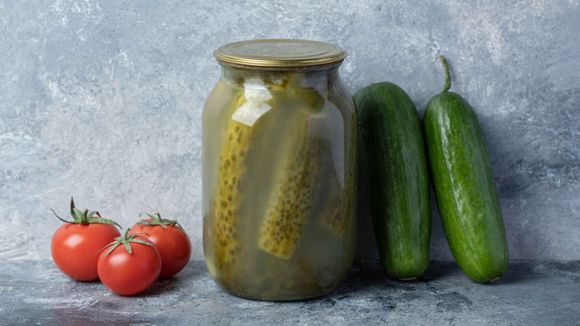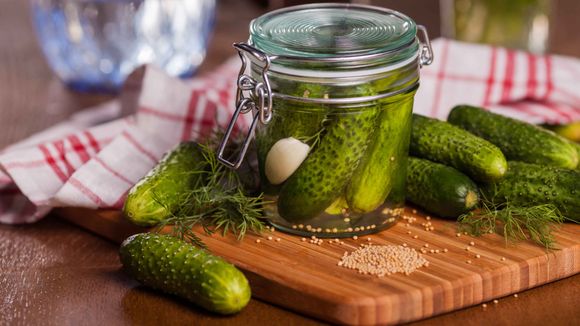Why eat pickles?
The quickest answer to this question is: because they are delicious, crunchy and naturally fermented. Fermented foods are nothing new to humanity. They have existed and enjoyed for hundreds of years. [ref. 2]
Although faster storage methods such as freezing and canning are used today, fermentation is one of the best ways to preserve the full composition of beneficial vitamins, minerals and enzymes in fruits and vegetables, and not only. Through fermentation, we even increase the benefits by adding probiotics to the composition of food. [ref. 3]
The Benefits of Fermented Foods
Recently, topics related to probiotics have been much discussed because of the need of modern man to further support his body at a time of increased levels of stress and overwork. The lack of varied and rich in useful ingredients food is also a factor that affects our quality of life. [ref. 3]
We add to this the disturbances of the digestive system such as dysbacteriosis, high intestinal permeability, problems with the absorption of micronutrients, Crohn's disease, etc., and we understand that we have more and more causes of discomfort associated with eating and absorption. It would be great to provide additional care and useful ingredients to the body from the comfort of our own home.
The difference between fermented pickles and marinated pickles
When it's summer and we are surrounded by a variety of fruits and vegetables, we often think about how we can preserve some of them in order to have access to quality and rich in vitamins and minerals foods in winter. Especially if we produce them ourselves.
Through fermentation and specifically lacto-fermentation, we can transfer some of the summer freshness and nutrition to the other seasons of the year.
In lacto-fermentation, there is a natural fermentation process that allows vitamins, minerals and enzymes to be preserved, and the probiotics to multiply and at the same time harmful bacteria to be limited and unable to grow.
With marinated pickles, many of these benefits are lacking. To obtain the marinade, the vegetables are poured with vinegar. Vinegar does not allow fermentation to develop, killing harmful bacteria, but also almost all useful. Many minerals also lose their potency during preservation. Thus, pickled cucumbers are poor in important micronutrients, their probiotic content is significantly reduced and there are almost no enzymes for digestion.
Crispy pickles according to a traditional recipe
The necessary ingredients for crunchy pickles according to a traditional recipe are:
- Cucumbers - of your choice
Indeed, there is no hard rule about what size of cucumbers is best for lacto-fermentation. If you have baby small cucumbers, you can put them whole. If they are medium to large size, you can cut them into four parts or into wheels - as you prefer them.
- Dill (Anethum graveolens) - flowers or seeds
- Garlic (A. sativum) - peeled into cloves
- Bay leaves (Umbellularia californica)
- Coriander seeds (Coriandrum sativum)
- Clove seeds (Syzygium aromaticum)
- Salt
Salt should be clean and free of stabilizers or other additives. Iodized salt has antimicrobial properties. As such, they would inhibit the development of bacteria, both harmful and beneficial.
This would not help fermentation, as it expects beneficial bacteria and probiotics to develop and multiply.
It is also important that the salt does not contain anti-caking agents that would also interfere with fermentation.
- Water
Water should be low to minimal chlorine levels. Chlorine, as we know, is used to prevent bacteria from growing in the water, but for our purposes it would prevent fermentation from developing. You can use distilled, purified, filtered or spring water.
- Suitable container - it is preferable to use glass or clay
- Cover for the fermentation process and lid for tight closure then
What are the steps of natural fermentation?

- Choose the right container for your purposes. This can be a jar of 0.5 l to larger sizes, such as 3 l. The larger the container you choose, the more brine you will need to prepare.
- Pour the coriander grains on the bottom, followed by fennel or seed blossoms. The flowers have a stronger and more intense aroma than the seeds, but if you have only seeds, they will be quite enough. Add them to the pot periodically while adding the cucumbers.
- Cucumbers should be stacked and pressed against each other so that they do not float during the fermentation process. As lacto-fermentation takes place, a light carbonation is formed, causing the contents to separate from the bottom.
- Garlic cloves and bay leaves can be added several times in different parts of the jar.
- Finish the arrangement with a fennel flower covering the cucumbers.
- Add the brine, leaving an airspace between the cucumber mixture with brine and the material with which you will cover the container. Once the brine comes into contact with the lactobacilli that live on the surface of vegetables and fruits, the beneficial bacteria begin to colonize, feeding on the natural sugars contained in their composition. Lactobacilli pre-metabolize some of the carbohydrates and thus facilitate the work of the digestive system. The slightly sour taste of pickles is due to the separated lactic acid during fermentation.
- Cover the container with paper, a piece of cloth or cheesecloth, finishing with an elastic so that it does not fall.
- Let the cucumbers ferment for between 7 and 8 days depending on the temperature of the room.
How much salt and how much water?
The salt concentration for suitable brine for fermentation should be between 4.0% and 4.25%.
The approximate salt-to-water ratio is 2 tablespoons of water for about 4 glasses of water. Or 21 grams of salt for 1 liter of water.
Regardless of the amount of cucumbers you want to use for lacto-fermentation, the salt concentration should be the same, and the amount of brine should change depending on what container you will use for your purposes.
The fermentation process is quite favorable and not so strict in terms of salt percentage. Even if you don't hit the percentages with precision, fermentation will make sure you get the desired product in the end.
Further guidance
- You will notice a change in the color of the brine - from crystal clear it will pass to turbid green. That's normal. Around the third day, small bubbles can be observed on the surface of the brine, which is due to the carbonate from the fermentation process. And this is normal, but not necessarily.
- For fermentation, you can use clay and glass vessels. In them, the process is most often successful.
- Don't worry if your fermentation fails from time to time. Not every time the development of beneficial bacteria defeats the development of harmful ones. If you find that mold has appeared on the surface, separate it with a wooden spoon and wipe the walls of the container with a cloth. Then add additional brine, letting it spill over the container so that the white particles can be poured if any remain.
- When fermentation is complete, close the container with a lid and store it in the refrigerator to keep the cucumbers for months.
- When eating cucumbers, do not throw away the brine. It can be very useful in flavoring salads or starting the next fermentation, adding only a spoonful of it to the new brine.
- If you use whole cucumbers, it is important to cut the end from which the plant has bloomed before it is picked and your kitchen countertop reaches it. If you leave it, it will affect the crispiness of fermented cucumbers and may turn out to be softer than your preferences. But apart from this slight difference, these cucumber ends do not interfere with the process in any other way.









